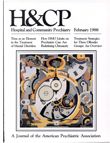Characteristics of State Hospital Patients Who Are Hard to Place
Abstract
As a result of deinstitutionalization, acute care beds in state hospitals have become blocked by patients who lack access to appropriate community placements but who have derived maximum benefit from hospital care. To help plan community services for these patients, this study identified and described patients at an Oregon state hospital who were hospitalized longer than therapeutically necessary because no community facility could treat them. A total of l46 patients were identified during a three-month period, and 81 were described; 65 percent were men, 70 percent were schizophrenic, and 90 percent presented a risk to themselves or others. The patients exhibited few strengths, and one-third had a substance abuse problem, at least one countertherapeutic attitude, or a need for medical monitoring. The authors describe how new community residential facilities can meet the needs of these difficult patients.
Access content
To read the fulltext, please use one of the options below to sign in or purchase access.- Personal login
- Institutional Login
- Sign in via OpenAthens
- Register for access
-
Please login/register if you wish to pair your device and check access availability.
Not a subscriber?
PsychiatryOnline subscription options offer access to the DSM-5 library, books, journals, CME, and patient resources. This all-in-one virtual library provides psychiatrists and mental health professionals with key resources for diagnosis, treatment, research, and professional development.
Need more help? PsychiatryOnline Customer Service may be reached by emailing [email protected] or by calling 800-368-5777 (in the U.S.) or 703-907-7322 (outside the U.S.).



